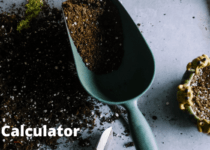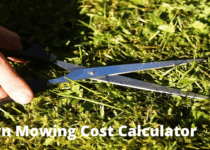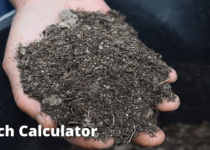Fertilizer Calculator
Why you should fertilize your lawn
Just like we humans require a balanced diet for healthy growth, grass also requires certain essential nutrients for normal, healthy growth. After you’ve put so much effort sowing grass seed or laying sod, keeping your lawn supplied with sufficient nutrients will help it grow stronger, look greener, and be more resistant to disease and drought.
The three key nutrients you need to pay most attention to for healthy grass growth are
- Nitrogen (N)
- Phosphorus (P)
- Potassium (K)
Nitrogen is the mineral nutrient required in the highest amounts by plants. Nitrogen deficiency typically results in the yellowing of leaves.
Phosphorus is an important component in photosynthesis, energy metabolism, and structural integrity. Phosphorus deficient grass may have slower growth and abnormally dark green or purplish colored leaves.
Potassium plays multiple roles related to photosynthesis, respiration and maintaining osmotic potential in plant tissues. Potassium deficiency can lead to yellowing or browning of the leaf tips and margins and weaker stems.
Grass also requires other nutrients such as calcium and magnesium. Sometimes these are present at sufficient levels the soil. If not, supplying additional nutrients may be beneficial. For example, it is common to supplement calcium using lime (which also raises pH) or gypsum.
You should familiarize yourself with the species of grass you want to grow so you can provide the optimal balance of nutrients for that species.
What does N-P-K on the fertilizer bag stand for?
The N-P-K numbers listed on a fertilizer label tell you what percent of the bag’s weight is composed of nitrogen (N), phosphate (P205) and potassium (K20).
If the fertilizer does not contain phosphate or potassium, such as organic fertilizers, the label will indicate the hypothetical weight of phosphate or potassium that would provide the same amount of P or K.
For example, a bag of kelp meal fertilizer with an NPK label of 1-0-2 would contain the same amount of potassium as a bag which contains 2% potash by weight.
How to choose a type of fertilizer?
You should generally look for a fertilizer with slow-release nitrogen, sometimes advertised as ‘controlled-release’ or ‘slowly available’ nitrogen. ‘Slow-release’ nitrogen has a number of advantages:
- The nitrogen will become available to the grass slowly over time, keeping the lawn well-fed for longer.
- You are less likely to overfertilize and burn your grass, creating brown patches in the lawn.
- They reduce water pollution from nitrate leaching, which occurs when too much nitrogen is released all at once.
Many organic fertilizers are also slow-releasing. Some high-quality fertilizers contain a mixture of slow-release and fast-release nitrogen to give your lawn a quick boost of color without causing burn.
If you live in colder regions, keep in mind that some fertilizers, including many organic fertilizers, need to be broken down by soil microbes before they will release nitrogen. These won’t provide nutrients as effectively in cold soils.
As for the NPK ratio, look to your local lawn experts, plant nursery or university extension for advice on your location. You will get the best results from the NPK fertilizer calculator by tailoring your fertilization scheme to your particular soil, grass species, and climate.
How to calculate fertilizer application rates per acre
If you have been recommended a rate of fertilization from your local lawn expert or from a soil test, how much fertilizer per acre do you need?
Recommendations may come in different units, including pounds of fertilizer per 1000 square feet, pounds per acre, or kilograms per hectare, but the calculation is the same regardless of units.
1. Calculate fertilizer application rate
To calculate fertilizer application rate, use the formula:
fertilizer application rate = desired N application rate / (%N on label / 100)
For example, if you had a fertilizer with NPK ratio of 28-0-6, and wanted to find out how much fertilizer per acre you need to reach an N application rate of 43 lbs/acre, you would calculate:
43 lbs N/acre / (28/100) = 154 lbs fertilizer/acre
2. Calculate how much fertilizer you need for your lawn area
Next, to determine how much fertilizer to apply to your lawn, multiply the fertilizer rate by the area of your lawn:
fertilizer weight required = fertilizer application rate * lawn area
If you don’t know your lawn area, use our area calculator to find out. You must ensure that the units for the lawn area match the units used for the application rate, but you won’t need to worry about converting units if you use our fertilizer calculator!
If the lawn was 1.5 acres, we would need:
1.5 acres * 154 lbs fertilizer/acre = 231 lbs of fertilizer
The fertilizer calculator also has a convenient bonus feature, where, if you enter in the weight of each fertilizer bag, it will tell you how many bags to purchase.
Why should I get a soil test?
While it may seem easier to follow general fertilizer recommendations, you can get a more accurate picture of how much of each nutrient your soil has from a soil test. There are four major advantages:
1. Match the needs of your grass
The soil test allows you to create a fertilization plan which meets the nutrient recommendations for your particular grass species.
2. Save money
By knowing how much of each nutrient your lawn already has, you will save money and prevent over-fertilization.
3. Avoid problems
Keep in mind that too much nitrogen leads to faster lawn growth, which just means that you’ll have to mow the lawn more often. Even worse, excess fertilizer can burn your grass or become a source of water pollution.
4. Monitor pH
A soil test will also tell you if your soil’s pH is too high or too low. Most lawn grass will do well with a pH between 6.5 and 7.0. If the pH is too high or low, the chemical reactions in the soil make it more difficult for the grass to absorb enough P and K. This can lead to poor grass health regardless of whether you applied the correct amount of fertilizer.
The soil pH can be adjusted using supplements. For example, you can raise the pH using lime, or lower the pH using granular sulfur.
When is the best time to fertilize?
Generally, for seasonal climates with winters below 55 °F (13 °C), the best time to fertilize is in the fall. Fall fertilization gives the grass a chance to build strong roots before the winter, so it will rebound quickly in the spring. Most grass experts recommend that if you fertilize once a year, the best choice is to fertilize in the fall.
Getting the right advice
Recommendations for the best timing and application rates for lawn fertilization vary based on climate, species, and region. You will have more confidence in your plan by seeking advice from your local grass experts, such as at a plant nursery or with a landscaping company. University extensions often publish detailed practical advice for the general public.
Some environmental considerations
It is important to remember that fertilizer can be harmful to local aquatic life if it enters waterways. How does this happen?
- Excess fertilizer from lawns and farms leaches out of the soil, and then enters storm drains and streams.
- In the water, fertilizer provides food for algae. The algae multiply, creating large algal blooms that can sometimes be seen by satellite images.
- Some species of algae produce toxins that harm humans and wildlife. Some algal blooms also deplete local oxygen levels when the algae die and decompose, creating “dead zones” where fish and other aquatic wildlife cannot survive.
Here are some ways to prevent pollution from fertilizers:
- Use only what your soil needs to prevent leaching
- Test your soil to ensure you don’t add nutrients that are already present in the soil
- Sweep up fertilizer on sidewalks and driveways to prevent it from falling into storm drains
- Consider spreading your fertilizer in multiple applications throughout the year but in smaller quantities
- Consider using organic fertilizers, which are less prone to leaching and can improve the structure of the soil
How to use the lawn fertilizer calculator – An example
How many bags of fertilizer do you need to achieve 1 lb of nitrogen per 1000 sq ft (43.56 lbs per acre) using a 25-5-10 fertilizer? Follow these steps using the lawn fertilizer calculator:
- Enter the
Lawn area, let’s say it’s50square meters. - Enter the
Fertilizer labelnumbers with25N,5P, and10K. - Enter the
N application rateat1lbs/1000 sq ft. - Read the result: The required
Fertilizer weightfor a lawn area of 50 square meters is4 lbs.
You can also see that this application will also add 0.2 lbs P2O5 and 0.4 lbs K2O per 1000 sq ft. You can check whether this meets the recommendations from a soil test or if additional supplements are required.



